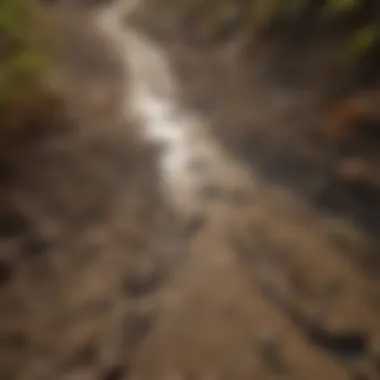Exploring Prime Deer Hunting Areas: Strategies and Insights


Intro
Deer hunting remains a cherished tradition for many, attracting diverse enthusiasts ranging from seasoned hunters to casual outdoor adventurers. Understanding prime deer hunting areas is not merely about the chase; it involves a comprehensive grasp of ecological elements and regulations that play a critical role in sustainable practices. The aim of this exploration is to dissect the various factors that shape deer populations and their habitats, ensuring that hunters benefit from a nuanced perspective.
A thorough analysis of forest ecosystems provides insight into how biodiversity affects deer hunting conditions. Residents and conservationists alike have key roles in maintaining woodland health, which, in turn, influences deer presence and behavior. This guide will further delve into strategic approaches that empower hunters to respect nature while enjoying their sport.
Intro to Deer Hunting Areas
Understanding the various deer hunting areas is crucial for both seasoned hunters and newcomers alike. The geographical and ecological features of these areas dictate not only deer populations but also the strategies and practices that hunters employ. Recognizing the significance of deer hunting stretches beyond mere sport; it intertwines with conservation efforts, agricultural practices, and wildlife management.
The relationship between hunters and the environment is complex. Successful deer hunting requires knowledge of the land, local wildlife, and regulations designed to sustain healthy populations. Moreover, understanding hunting’s role in population control of deer offers significant ecological benefits. It aids in managing habitats, ensuring food availability, and reducing overpopulation, which can lead to human-wildlife conflicts.
Furthermore, hunting is not just about the chase; it emphasizes responsibility towards the environment and the necessity of adherence to regulations. This section aims to lay the groundwork for comprehending the essential elements influencing deer hunting areas, thus ensuring that one is well-equipped with necessary knowledge before embarking on the hunt.
The Importance of Deer Hunting
Deer hunting holds a critical place in the cultural and ecological landscape of many regions. It provides not just recreation and sustenance but also serves as a tool for managing local ecosystems. Responsible hunting can reduce deer populations to levels that the habitats can support, thus enhancing the overall health of both fauna and flora in the region.
Moreover, hunting often fosters a deep sense of connection with nature. It encourages hunters to actively engage with their environment, develop skills in tracking, and understand the behaviors of deer. This knowledge can lead to greater receptivity towards wildlife conservation efforts, promoting awareness about different species and their ecosystems.
Finally, economically, deer hunting contributes significantly to local communities. It provides jobs related to equipment, lodging, and food services, creating a robust economic engine in rural areas while promoting a culture of respect and stewardship towards wildlife.
Overview of Hunting Regulations
Hunting is governed by a myriad of regulations, which aim to ensure sustainability and ethical practices. Each state or region has its own set of rules regarding hunting seasons, licensed hunting, and bag limits to maintain ecological balance. These regulations are crafted based on extensive research into wildlife populations and ecosystems.
Understanding and adhering to these regulations is essential for every hunter. A violation can lead to legal repercussions and strikingly detrimental effects on wildlife management efforts. This adherence also safeguards against negative public perceptions of hunting, which can undermine conservation initiatives.
Hunters should familiarize themselves with local laws regarding:
- Licensing requirements: It is essential to possess the necessary permits before hunting.
- Seasonal guidelines: Specific dates indicate when hunting for particular deer species is permissible.
- Bag limits: These limits are established to prevent overhunting and ensure the viability of deer populations.
A comprehensive understanding of these regulations can enhance the hunting experience while promoting responsible practices in the field.
Geographical Distribution of Deer
Understanding the geographical distribution of deer is crucial for any hunting enthusiast and conservationist. Deer populations vary based on a variety of factors, including environmental conditions, habitat quality, and human activity. By analyzing this distribution, one can identify prime hunting areas that not only sustain deer populations but are also accessible to hunters. This section will explore the distinct habitats where deer thrive and highlight differences between urban and rural areas, emphasizing considerations relevant to both hunting strategies and conservation practices.
Regional Habitats
Different regions support varying habitats that are conducive to deer living. These habitats are influenced by climate, vegetation, and topography. Each region can offer unique opportunities for hunting based on these factors.
- Northeastern United States: This area is characterized by dense forests interspersed with agricultural lands. White-tailed deer are common here, benefiting from the richness of crops and cover provided by woodlands.
- Midwestern United States: Known for its corn and soybean fields, this region creates a feeding frenzy during the fall. The combination of agricultural abundance and suitable breeding habitats elevates deer populations significantly.
- Southern States: Warm climates allow for year-round growth of vegetation, which supports larger deer populations. The diversity of habitats from marshlands to uplands plays a role in successful hunting strategies.
- Western Regions: Deer here often adapt to harsher climates and varied terrain. Mule deer are prevalent, often found in mountainous areas with sparse vegetation. Hunting success here may depend on understanding their migratory patterns between seasonal feeding grounds.
Identifying these regional habitats allows hunters to tailor their approaches, whether it be choosing the right gear, timing their hunts, or understanding deer behavior in different environments.
Urban vs. Rural Areas
The contrast between urban and rural areas presents distinct challenges and opportunities for deer hunters. Urban areas, often seen as unfriendly to wildlife, can still support significant deer populations.
- Urban Areas: Increased development leads to habitat fragmentation but also creates unique niches for deer. They often thrive on gardens and shrubs in suburban settings. However, hunting in urban areas is governed by strict regulations, with opportunities often limited to specific seasons and methods. Hunters must be mindful not only of regulations but the potential for human encounters.
- Rural Areas: These regions usually provide more extensive and undisturbed habitats. The availability of food and cover tends to be higher, making rural areas ideal for hunting. Hunters can exploit natural deer trails and use wind directions to their advantage while tracking.
"Understanding the interactions between deer populations and their surroundings is vital for successful hunting as well as conservation development."
Ultimately, choosing between urban and rural hunting requires careful consideration of legal constraints and personal preferences. Each environment offers its own advantages and drawbacks, and successful hunters must adapt their strategies accordingly.
Key Factors Influencing Deer Populations
Deer populations are not static; they fluctuate due to a variety of environmental and biological factors. Understanding these influences is essential for those involved in hunting and conservation. The interplay between food availability, water resources, and suitable habitats determines the health and number of deer in a region. Knowledge of these key factors can guide hunting strategies and improve conservation efforts.
Food Sources
Food is a fundamental necessity for deer. The availability of nutritious forage directly impacts their growth, reproduction, and survival rates. Deer are herbivores, predominantly grazing on grasses, leaves, fruits, and nuts. Regional variations can heavily influence which food sources are most abundant. In agricultural areas, corn and soybeans often serve as plentiful food sources, while forests may provide acorns, berries, and woody browse.


Moreover, the seasonal change in food availability is a significant consideration for hunters. During the fall, deer typically consume a diet rich in acorns and mast, fattening up for the winter. Conversely, as winter approaches, the accessibility of understory vegetation decreases, forcing deer to search harder for food. Establishing food plots can enhance deer health and attract them to specific areas, making it a useful strategy for hunters. Considerable research points to the need for habitat diversity to ensure adequate food sources year-round.
Water Availability
Water is a critical resource for deer, influencing their movements and habitation. Deer require access to freshwater daily. The presence of streams, ponds, and wetlands creates prime habitats. These water sources can dictate where deer will reside and feed. In dry seasons or drought conditions, water availability becomes even more crucial, often leading to congregation near dwindling sources.
Hunters should take note of water sources when scouting for deer. By identifying such locations, they can increase their chances of encountering deer as they travel to drink. It is also worth noting that water availability influences breeding. Taking care of these essential natural resources is vital for sustaining healthy deer populations.
Cover and Breeding Habitat
Cover is vital for providing deer with security from predators and a place to rest and breed. Dense thickets and tall grasses offer essential cover, allowing deer to avoid detection. Moreover, specific habitat features, such as brush piles and fallen logs, also contribute to an environment where deer feel safe. Hunters should thus identify areas with these covers to enhance their encounters.
Breeding habitat is equally important, particularly during the rut - the mating season for deer. Doe populations seek safe areas for birthing fawns, so access to secure, nutrient-rich cover can impact fawn survival rates. Providing such habitats can benefit not only deer populations but also enhance hunting opportunities. Advanced knowledge of ecological features can help guide effective conservation methods as well.
"Understanding the dynamic interplay of food, water, and cover can lead to better hunting success and improved conservation strategies."
Recognizing these factors fosters informed decision-making for both hunters and conservationists. By comprehensively analyzing food sources, water availability, and cover, stakeholders can better manage deer populations and sustainable hunting practices.
Seasonal Variations in Hunting
Understanding seasonal variatons in deer hunting is critical for successful hunts. These variations affect deer behavior, migration patterns, and ultimately hunting success. By acquiring knowledge about how seasons influence deer movements and habits, hunters can make informed choices, adapting strategies to align with natural deer activities. Seasonal changes bring forth varying environmental conditions that impact not only deer but also hunting methods.
Understanding Deer Behavior
Deer behavior fluctuates with the seasons. During the early part of the year, deer may focus on feeding heavily in preparation for mating season. In late summer, deer tend to herd together and show less interest in mating. As autumn approaches, the onset of cooler temperatures and shorter days triggers the rutting season. This is when male deer become more aggressive as they compete for breeding rights. Additionally, females become more active during this period, increasing the chances of sighting during hunts.
Factors influencing deer behavior include the availability of food and water, shelter from environmental conditions, and the presence of predators. In spring and summer, deer often seek rich foraging areas, while in winter, they move towards sheltered locations. Weather plays a role as well, where rain or snow can alter their usual paths.
Optimal Hunting Seasons
Determining the optimal hunting seasons is essential for maximizing chances of a successful hunt. Each region has specific regulations regarding hunting seasons. Familiarizing oneself with these can greatly improve overall hunting experience.
In general, the prime hunting season occurs during the rut. The months of October through December generally offer the best opportunities. Here are a few considerations when planning:
- Pre-Rut (September to October): Males begin to mark territories and become more active. Hunting strategies during this period involve using attractants and scents to lure bucks.
- Rutting Season (November): This is when deer are most active, particularly in the mornings and evenings. During this time, hunters should maximize their stands during dusk to capture movement.
- Post-Rut (December): Although less active, deer still move to food sources. Focusing on areas with high food density can yield results during this period.
Understanding these seasons and behaviors allows hunters to select the most advantageous times to pursue deer. Optimization of strategy in accordance with the seasons leads to greater success and enhances overall enjoyment of the hunting experience.
"Adapting to seasonal changes is crucial for effective deer hunting. Knowing when deer are likely to be active allows hunters to strategize and prepare accordingly."
In summarizing, seasonal variations significantly influence both deer behavior and hunting success. Recognizing these elements helps hunters achieve better outcomes and develop a deeper appreciation of deer hunting harmonized with ecological patterns.
Techniques for Identifying Prime Hunting Areas
Identifying prime hunting areas requires a combination of methodical scouting, understanding deer behavior, and leveraging technology. These techniques help hunters maximize their chances of success while respecting wildlife and their habitats. The effectiveness of choosing a location can directly influence the outcomes of a hunting expedition. Therefore, developing an informed approach is crucial.
Scouting Locations
Scouting is the foundational step to identifying ideal hunting spots. It involves physical exploration of the land to collect vital information. This includes understanding the terrain, identifying feeding patterns, and locating trails or bedding areas used by deer. Key benefits of scouting include:
- Knowledge of Deer Habitats: By exploring different locations, hunters gain insights into where deer congregate, particularly during feeding times or mating seasons.
- Assessment of Accessibility: Scouting allows for evaluation of how easily a hunter can access chosen spots without alarming deer.
- Observation of Wildlife Behavior: Noting other wildlife can indicate the overall health of the ecosystem and help gauge deer population density.
Efficient scouting can be accomplished by visiting areas both early in the morning and late in the evening; these are typically the times deer are most active. It's advisable to keep a journal for observations, marking locations of interest precisely.
Utilizing Trail Cameras
Another effective technique for identifying prime deer hunting areas is the use of trail cameras. These devices capture images and videos of wildlife movement in specific areas. Utilizing trail cameras has several advantages:
- Real-Time Data Collection: Trail cameras provide an objective way to monitor deer activity without human presence, which is vital for obtaining natural behavior patterns.
- Historical Tracking: Reviewing past footage can reveal trends in deer movement, allowing hunters to predict future behavior based on seasonal changes.
- Layering Information: Combining trail camera data with scouting findings enhances decision-making. This holistic approach is beneficial for understanding not just where deer are, but when they are most active.
"Acquiring trail camera data over time is akin to building a comprehensive profile of the local deer population and their habits."
The Role of Conservation in Hunting Areas


Conservation plays a crucial role in ensuring that deer hunting remains sustainable and viable for future generations. Engaging in deer hunting is more than merely pursuing animals; it demands a comprehensive understanding of the surrounding ecology. Conservationist efforts intertwine with hunting traditions to promote biodiversity and maintain healthy ecosystems. This dynamic relationship between hunters and conservationists emphasizes the need for responsible practices that benefit not just the target species, but also the habitat and other wildlife.
Sustainable Hunting Practices
Sustainable hunting practices are essential for maintaining deer populations and their habitats. These practices involve several principles aimed at reducing negative impacts while maximizing the ecological benefits of deer hunting. Important aspects of sustainable hunting include:
- Selective Harvesting: Taking only certain animals from a population can help maintain genetic diversity and prevent overpopulation.
- Monitoring Populations: Regular assessments of deer populations help ensure that hunting practices align with the current status of the ecosystem, allowing for adjustments in license quotas and hunting areas.
- Habitat Preservation: Engaging in activities that protect and restore habitats can create healthy environments for deer. This combines proactive habitat management practices such as reforestation and wetland restoration.
By adhering to these sustainable hunting methods, hunters not only enjoy the sport but also contribute positively to the environment.
Impact of Hunting on Ecosystems
The impact of hunting on ecosystems is multifaceted, providing both potential risks and benefits. Responsible hunting can lead to healthier deer populations, which in turn supports overall ecosystem health. Key points to consider include:
- Regulating Populations: Effective hunting can help control deer numbers, preventing overgrazing of vegetation. This balance can protect biodiversity within their habitats.
- Nutrient Cycling: Deer serve as a part of the nutrient cycle. When hunted responsibly, the decomposition of their carcasses returns nutrients to the soil, which benefits plant life and indirectly supports other wildlife species.
- Conflict Reduction: In some areas, hunting can mitigate human-deer conflicts, reducing property damage and car collisions, which can have broader social and economic implications.
"Conservation efforts are vital for striking a harmonious balance between recreation and ecological integrity. It allows hunters to engage ethically while fostering a net positive influence on wildlife habitats."
Legal and Ethical Considerations
The realm of deer hunting encompasses more than just the thrill of the chase; it is steeped in legal frameworks and ethical standards that ensure the sustainability of wildlife populations and the integrity of the practice itself. Understanding legal and ethical considerations is crucial for every hunter, as these guidelines not only protect deer populations but also preserve the hunting experience for future generations. This section will address the significance of hunting licenses and permits, as well as the principles of fair chase that hunters should abide by to honor the wildlife and the environment in which they operate.
Hunting Licenses and Permits
Hunting licenses and permits represent the legal prerequisite for engaging in hunting activities. These documents are essential to ensure that hunters comply with state, local, and federal regulations. The requirements for licenses may vary greatly across different regions, and understanding local laws is paramount.
Benefits of Obtaining Licenses:
- Conservation Funding: Fees often contribute to wildlife conservation efforts, habitat preservation, and wildlife management programs.
- Regulatory Compliance: They help ensure that hunters are informed about local rules, such as bag limits and designated hunting seasons.
- Accountability: Licenses allow authorities to track hunting activities and enforce laws, discouraging poaching and unethical practices.
Important Aspects to Consider:
- Hunters should familiarize themselves with the specific requirements in their hunting area. This includes understanding residency requirements, age restrictions, and whether a hunter safety course is necessary.
- Each state has its own regulations regarding species and weapon restrictions. Awareness of these rules is key to ensuring a responsible hunting practice.
Fair Chase Principles
The principle of fair chase is an ethical guideline guiding hunters to conduct their activities in a manner that ensures a well-managed hunting ecosystem. It encompasses respect for wildlife and adherence to a code of conduct, reflecting the hunter’s responsibility to the resource they utilize.
Key Points of Fair Chase:
- Respect for Animals: Fair chase implies giving deer a fighting chance, which limits the use of technology that would provide an unfair advantage. For instance, relying on drones or other advanced surveillance technology can violate this principle.
- Ethical Harvesting: When a hunter makes a kill, it is critical to do so humanely, minimizing suffering and ensuring retrieval. Utilizing appropriate weaponry and skills is essential for this.
- Minimum Interference: Hunters should respect the natural behaviors of deer by selecting locations and times that do not disrupt their routines.
"The ethical hunter seeks to minimize the impact on the ecosystem while maximizing the value of their harvest, practicing stewardship of wildlife populations and their habitats."
In summary, legal and ethical considerations are foundational to responsible hunting. Obtaining the necessary licenses ensures compliance with laws, while embracing fair chase principles elevates the hunter’s respect for wildlife. Hunters must recognize that their practices today shape the traditions of hunting tomorrow.
Popular Deer Hunting Areas by Region
Understanding popular deer hunting areas by region is essential for both novice and experienced hunters. Each area offers unique ecological settings, deer behaviors, and regulations which directly impact hunting success. By identifying these prime locations, hunters can maximize their chances of encountering deer in their natural habitats, while also adhering to local conservation practices.
Northeastern United States
The Northeastern United States is known for its diverse landscapes and robust deer populations. States such as Pennsylvania, New York, and New Jersey feature dense forests, which provide ample cover and food sources for deer.
Hunters in this region benefit from varied terrain including hilly areas and wetlands. The mix of habitat types provides a rich environment for deer to thrive. The hunting seasons are generally well-defined, offering opportunities both for bow hunting and firearm encounters. Local regulations often emphasize sustainable practices to maintain healthy deer populations.
Factors such as acorn availability from oak trees during the fall can affect deer movement patterns, making scouting methods such as observation and track identification critical during this season.
"In the northeast, the changing seasons influence deer behavior greatly; understanding these patterns is vital for effective hunting."
Midwestern Hotspots
The Midwest region, especially states like Illinois, Iowa, and Wisconsin, is famed for monster bucks and favorable hunting conditions. This area's agricultural landscape plays a crucial role in attracting deer. Corn and soybean fields provide substantial food sources, especially during farming seasons.


The Midwestern states also highlight the importance of access to both public and private lands. While many hunters obtain licenses for public land hunting, securing permissions for private land can yield even greater rewards. The balance between harvest regulations helps ensure beginner and expert hunters can find success while conserving the ecosystem.
The terrain varies slightly, with rolling hills and river valleys presenting unique strategies for hunters to consider throughout the hunting seasons.
Southern States Overview
Southern states like Texas, Georgia, and Alabama present distinct approaches to deer hunting due to warmer climates and extended hunting seasons. Here, whitetail deer are abundant, and hunters experience various ecosystems including swamps, pine forests, and open plains.
Hunting pressure is often lighter in some areas, especially where agricultural practices minimize disruption. The extended hunting season allows for family outings and less competition compared to the northern states. Understanding local wildlife management policies becomes essential as some areas support specific hunting methods, including dog hunting, which may be unique compared to the rest of the country.
Success in southern hunting typically comes from knowing the correct baiting techniques and being patient.
Western Regions of Interest
In the western United States, states like Colorado and Montana showcase vast wilderness areas that offer diverse species of deer, such as mule deer. The rugged terrains, with mountains and valleys, provide hunters with challenging opportunities that require good physical fitness and advanced hunting skills.
Local regulations might vary significantly compared to eastern regions, including more substantial licenses based on species and sex of the deer. Here, scouting becomes more critical, as spotting game might involve covering large areas. Public lands are abundant and often require detailed maps and navigation systems to ensure successful hunts.
Hunters can benefit from integrating technology like GPS tools to track their movements and locate deer more efficiently in these expansive regions.
Emerging Technologies in Deer Hunting
The landscape of deer hunting continues to evolve, shaped significantly by advancements in technology. Emerging technologies enhance the efficiency and effectiveness of hunting practices, providing hunters with tools that make it easier to locate and track deer. These innovations not only improve individual success rates but also contribute to responsible wildlife management. Understanding these technologies is essential for any hunting enthusiast looking to elevate their skills and practices.
GPS and Navigation Tools
GPS technology has revolutionized deer hunting by providing accurate location data. With devices capable of delivering real-time information, hunters can navigate vast landscapes with confidence.
- Accuracy - GPS ensures that hunters can pinpoint their locations exactly. This precision is vital when navigating through unfamiliar terrain or dense forests.
- Mapping Features - Many GPS devices allow hunters to create and save maps. This feature helps in marking important areas, such as where deer are typically spotted or where feeding grounds are located.
- Tracking Movement - Some systems integrate with tracking collars, enabling hunters to monitor the movement of deer. This can be particularly beneficial during the hunting season when understanding deer behavior is critical.
Nevertheless, it is important to recognize the limitations as well:
- Battery Life - Users must be aware that extended use can drain batteries, so planning is key.
- Hunting Regulations - Some locations restrict the use of electronic devices. Hunters need to ensure they comply with local laws concerning technology in hunting.
Smartphone Applications
Smartphones have become powerful tools in the field of deer hunting. The availability of specialized apps enhances the hunting experience through several features:
- Weather Tracking - Apps can provide current weather conditions and forecasts, crucial for planning hunting trips.
- Social Sharing - Many applications allow hunters to share their experiences, track fellow hunters, and even collaborate on hunting strategies.
- Resourceful Guides - Some apps include educational materials, such as tips on deer behavior and proper tracking techniques.
Moreover, smartphones host various community forums where hunters can exchange tips or report deer sightings. The integration of technology into these platforms has made information more accessible than ever.
"The use of technology in hunting has created a more informed and strategic approach to deer hunting that benefits both the hunter and the ecosystem."
Epilogue: The Future of Deer Hunting Areas
The landscape of deer hunting is evolving. As society changes, so do the approaches to wildlife management and hunting practices. Understanding the future of deer hunting areas is not just about anticipating changes; it is crucial for formulating effective strategies that ensure sustainable deer populations and their habitats.
Trends in Deer Population Management
Effective management of deer populations involves several key trends that weigh ecological, social, and economic factors. One significant trend is the increased emphasis on data-driven decision-making. Officials are relying more on scientific studies and population monitoring to guide hunting quotas, seasons, and methods. The integration of technology such as GPS tracking plays a vital role in understanding deer movements and behaviors. This precision allows managers to meet population goals more effectively.
Another trend is the growing popularity of community engagement in wildlife management. Hunters and conservationists alike recognize that local input can significantly enhance management strategies. Collaborative approaches can educate the public on the ecological role of deer and address human-wildlife conflicts. Community buy-in is essential for successful management.
Furthermore, there is a shift towards recognizing the need for diversity in deer management practices. Different regions have unique ecological and social landscapes that require tailored solutions. For instance, urban hunting policies may significantly differ from those in rural settings, influenced by factors such as population density and habitat availability.
- Increased reliance on data-driven decision making.
- Emphasis on community engagement in wildlife management.
- Recognition of regional diversity in management practices.
Adaptive Conservation Strategies
The future of deer hunting also hinges on adaptive conservation strategies. These strategies are designed to be flexible, allowing for modifications in response to changing environmental conditions, regulations, and societal needs. One approach is incorporating adaptive management frameworks that encourage ongoing monitoring and adjustment based on observed outcomes. This can be particularly useful when addressing issues related to climate change, which can impact deer habitats profoundly.
Additionally, there is a push for integrated land use planning. Landowners, agricultural interests, and conservationists must collaborate to find a balance between development and the preservation of deer habitats. This holistic way of thinking ensures that all stakeholders' concerns are considered, leading to better outcomes for deer populations and other wildlife.
Finally, raising awareness about the importance of biodiversity is essential. Promoting healthy ecosystems supports not only deer but also a wide range of species. By fostering diverse habitats, we can create a more resilient environment that can better withstand environmental changes.
"Sustainable practices in deer hunting are crucial for maintaining healthy populations and a thriving ecosystem."
In summarizing the future of deer hunting areas, it is clear that ongoing research, community engagement, and adaptive management are paramount. As we continue to navigate these complexities, the objective should always be to find a balance that respects wildlife and offers quality experiences for hunters.















